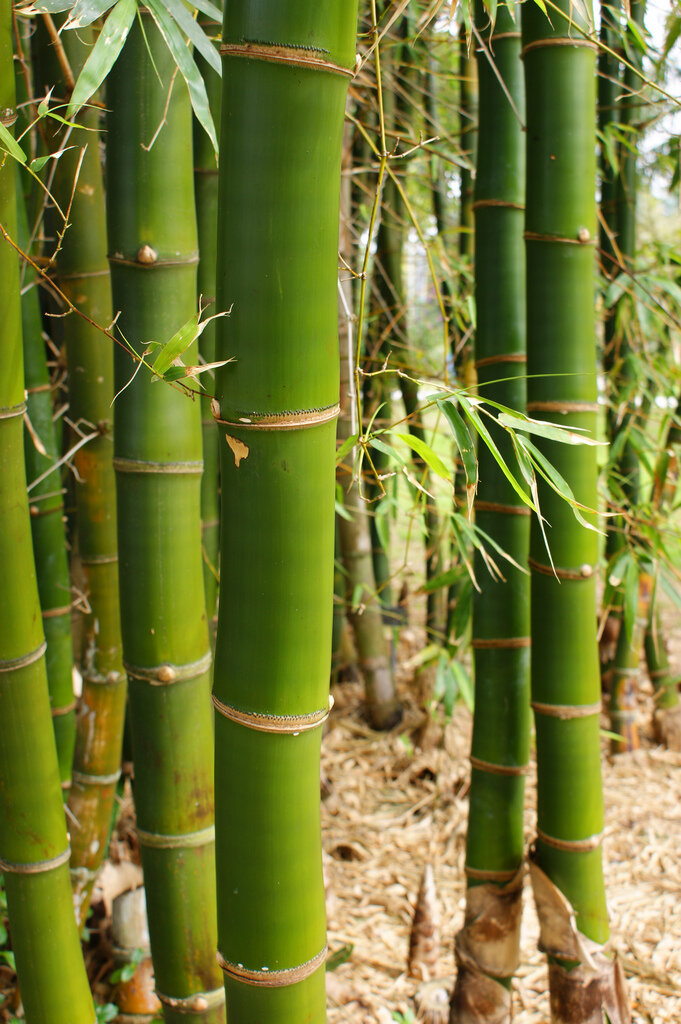Bambusa vulgaris
Bambusa vulgaris also known as Common Bamboo is a giant tropical and subtropical clumping bamboo native to southern China and Madagascar. This species is cultivated extensively in many parts of the world.
| Plant Info | |
|---|---|
| Scientific Name | Bambusa vulgaris |
| Synonyms | |
| Common Names | Common Bamboo |
| Family | Poaceae |
| Tribe | Bambuseae |
| Genus | Bambusa |
| Height | 15 - 20 m |
| Diameter | 4 - 10 cm |
| Growth Habit | Clumping |
| Climate | Tropical - Subtropical |
| Hardiness | -1°C |
| Edibility | (3 of 5) |
| Flowering Cycle | 80-150 years |
| Origin | Cambodia, China, Laos, Myanmar, Thailand, Vietnam |
| Uses | Light Construction, Basketry, Plant Support Sticks, Paper Pulp, Ornamental |
Bambusa vulgaris culms are bright green, glossy, erect below and arching above and have an average height between 10-20 m. Internodes are 25-35 cm long, and have an average diameter of 4-10 cm. Wall thickness ranges between 7-15 mm. Nodes are prominent, of which the lower ones often with a narrow ring of roots and covered with brown hairs.
Culms
Branches
Several to many clustered branches with 1-3 larger dominant branches. Branches usually occur from mid-culm to top.
Leaves
Narrow leaves which are on average 15-25 cm long and 2-4 cm wide.
Habitat
Bambusa vulgaris often occurs spontaneously or naturalized on river banks, roadsides, wastelands and open ground, generally at low altitudes. In cultivation it grows very vigorous on moist soil and under humid conditions but tolerates a wide range of climatic conditions and soil types up to 1,200 m altitude. In dry season the bamboo plants may become completely defoliated but recuperate once rainy season starts. This bamboo species can survive low temperatures up to -3°C and has a high adaptation to semi-arid areas, and on degraded and flooded lands.
Uses
Bambusa vulgaris is widely planted and used for a variety of purposes, primarily for use in light construction such as houses, huts, boats (masts, rudders, outriggers, boating poles), fences, scaffolding, furniture, musical instruments and handicrafts.
Culms are also used as carrying poles or banana plant supports. Split stems are used for brooms, baskets, and rings prepared from the split culms are put into ear perforations by the Tunkul-Naga tribes of Manipur. In New Guinea culms are used to make traditional combs and penis gourds ('koteka') in the phallocrypt tradition.
This bamboo is also an excellent raw material for paper and pulp production. Laboratory studies and pilot trials of pulp made from this species growing in Africa indicate its potential value, especially for mixing with hardwood pulps.
Young shoots are edible but of average to poor quality, therefore shoots are rarely used as a vegetable. Leaves are sometimes used as forage or livestock fodder although toxic effects to horses where noted.
As a medicine, chloroform extract of the leaves is used against Mycobacterium tuberculosis. Tabasheer from culm internodes is used to treat infantile epilepsy, fever and hematuria, kidney troubles, bark astringent and emmenagogue (to stimulate or increases menstrual flow), and as an abortifacient (to cause abortion).
Bambusa vulgaris is often planted as an ornamental bamboo or to form hedges to border land. It can be planted on slopes to control erosion.
Origin
Native to:
Cambodia, China, Laos, Myanmar, Thailand, Vietnam
Introduced into:
Bangladesh, Benin, Brazil, Burkina Faso, Bhutan, Cameroon, Colombia, Comoros, Congo, Cook Islands, Costa Rica, Cuba, Dominican Republic, Ecuador, El Salvador, Ghana, Guatemala, Guinea, Haiti, Honduras, India, Indonesia, Ivory Coast, Jamaica, Japan, Libya, Madagascar, Malaysia, Maldives, Mali, Mauritius, Mexico, Myanmar, Nepal, Nicaragua, Nigeria, Panamá, Papua New Guinea, Peru, Rwanda, Seychelles, Sierra Leone, Sri Lanka, Togo, Tonga, Trinidad and Tobago, USA, Venezuela.






















Date planted: 7 June 2022
Growth update:
Adopted by: